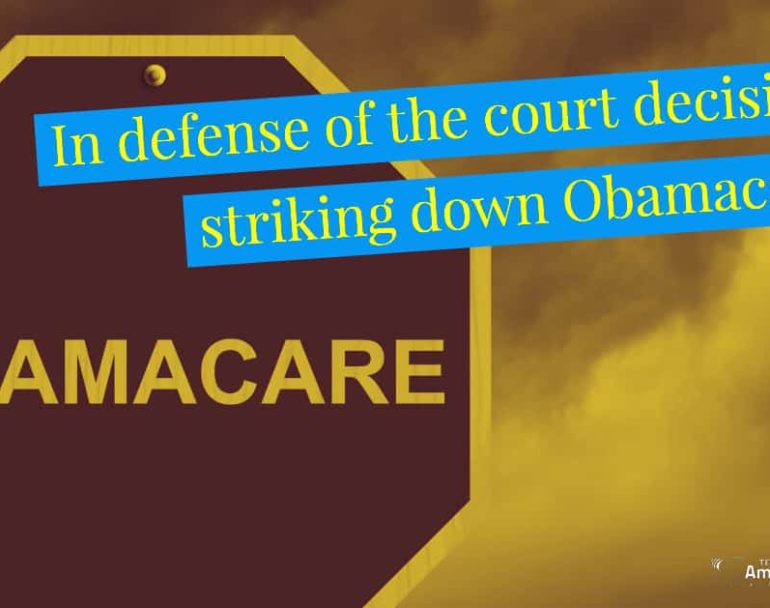
In defense of the court decision striking down Obamacare
By: Rob Natelson
The outrage against the latest court decision striking down the Affordable Care Act (ACA or Obamacare) is misplaced.
Much of it comes from people – particularly liberal law professors – who thought the latest suit against the ACA had no chance because it was “absurd” and “nonsense.” No one likes to be proven wrong, especially not law professors.
Yet the truth is that one of Judge Reed O’Connor’s rulings seems inescapable. This was his conclusion that the ACA’s mandate requiring people to buy government-approved health insurance is no longer constitutional. In 2012, the Supreme Court upheld that mandate only because it was supported by a financial penalty the court found to be an “indirect tax.” The court found that other parts of the Constitution did not support the mandate. So when Congress repealed the penalty last year, it left the mandate without any constitutional legs.
Judge O’Connor further ruled that without the mandate, no other part of the ACA can stand, because without the mandate Congress would not have enacted the rest of the law. In legal terms, the judge held that the mandate was not “severable” from the rest of the ACA.
Like most commentators, I initially questioned Judge O’Connor’s non-severability decision. But his 55-page opinion thoroughly buttresses it.
The judge’s opinion shows that the ACA itself affirms explicitly and repeatedly that the mandate is essential to the rest of the law. Just one example: Section 18091(2)(H) of the ACA states that “The requirement [mandate] is an essential part of this larger regulation of economic activity, and the absence of the requirement would undercut Federal regulation of the health insurance market.” That is apparently why the ACA, unlike many other complicated statutes, does not have a severability clause. That is, it does not say that if one part is void, the other parts survive.
Functionally, the entire ACA revolves around the mandate. The mandate forces people to buy health insurance, giving insurance companies and health care providers more revenue. The added revenue enables the companies and providers to pay for the ACA’s new taxes and regulations. And the new taxes and regulations help people comply with the mandate because (1) the tax money pays for subsidies (including tax credits) and (2) the regulations—supposedly—reduce costs.
“Shared responsibility” is the ACA’s name for this creaky wheel of mandate, taxes, regulations, and subsidies.
As Judge O’Connor also notes, in the 2012 ACA case, all nine Supreme Court justices admitted the tie between the mandate and the rest of the law. Four justices specifically addressed whether the mandate could be severed from the remainder. All four agreed that it could not. They compared the ACA to a decorated Christmas tree: Take away the tree (the mandate), and the ornaments no longer serve their purpose.
Three years later the Supreme Court rescued ACA tax credits from the law’s bad drafting. Central to the court’s holding was the tight interconnection between different parts of the statute: tax credits, the mandate, and so forth.
The best argument for separating the mandate from the rest of the ACA is that in 2017 Congress repealed the tax penalty for violating the mandate but left the rest of Obamacare in place. But as Judge O’Connor points out—
* Congress repealed only the penalty, not the mandate. It retained the mandate as an unconditional command, no longer as a mere condition on a tax.
* Congress also retained the ACA’s language about how “essential” that mandate was to the rest of the law.
* Congress did nothing to contradict the Supreme Court’s view that the mandate was essential.
Thus, the 2017 Congress sent the following message, “We no longer want the penalty, but we still want the mandate. If the mandate is void, then let the ACA collapse and we’ll try something different.”
Some commentators argue that the plaintiffs did not suffer damage, and therefore had no standing to sue. I agree that standing for the two individual plaintiffs was debatable. I think Judge O’Connor’s treatment of standing should have been more thorough. But there were 20 other plaintiffs as well – 19 states and a state governor. The ACA affects them financially and in other ways. The states had standing in this case for much the same reasons they had standing in earlier Obamacare litigation.
In any event, it ill-befits liberal critics to complain about standing. Some of their favorite Supreme Court decisions were issued only because the court finessed standing requirements.
Still another charge against Judge O’Connor is that voiding the ACA is “disruptive.” In the real world, of course, law professors and other commentators charge “disruption” only against court decisions they don’t like. Most fully support very disruptive decisions, so long as the results are liberal.
The truth is that the quiet death of the ACA would surely be less disruptive than its chaotic life. (People can respond best if government leaves them free to do so.) The states can help by establishing pre-existing condition pools and resuming their traditional governance of insurance and health care.
Finally: Some critics complain that Judge O’Connor’s opinion was too “activist.” But his job was to apply the law, and he seems to have done that responsibly. Certainly the relief he granted is far less activist than the nationwide injunctions liberal judges are issuing these days.
Although it is unclear whether Judge O’Connor will be sustained on appeal, his decision is a well-reasoned one. It is sad that so many commentators chose to trash it without fair consideration.